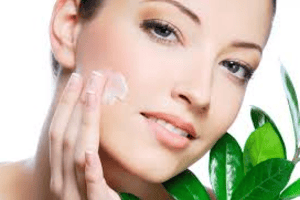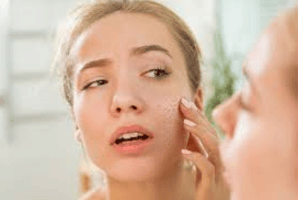Are you tired of dealing with flaky, tight, or uncomfortable dry skin? You’re not alone. Millions of people struggle with dry skin, especially during seasonal changes or in harsh climates. Finding the right can feel overwhelming with countless products promising miraculous results.
But don’t worry – this comprehensive guide will walk you through everything you need to know about nurturing your dry skin back to health. Whether you’re dealing with occasional dryness or chronic conditions like eczema, you’ll find practical, effective solutions here.
Let’s transform your skincare routine together and say goodbye to dry, uncomfortable skin for good.

Understanding Dry Skin: Why Is Your Skin So Thirsty?
It’s critical to understand the underlying causes of your dry skin. Dry skin (clinically known as xerosis) occurs when your skin lacks moisture and natural oils. This can happen for several reasons:
Environmental factors:
- Low humidity, especially during winter
- Exposure to harsh weather conditions
- Excessive air conditioning or heating
- Hot showers and baths
- Chlorinated pools
Internal factors:
- Genetics and natural skin type
- Age-related changes (skin becomes drier as we age)
- Underlying skin disorders such as eczema or psoriasis
- Hormonal changes
- Dehydration
- Side effects of medications
Skincare habits:
- Using harsh soaps and cleansers
- Over-exfoliating
- Not moisturizing consistently
- Using products with irritating ingredients
Understanding the root causes of your dry skin is the first step in developing an effective skincare for dry skin routine. By identifying your specific triggers, you can make targeted changes that will have the greatest impact.
The Perfect Skincare Routine for Dry Skin
Creating a consistent skincare routine specifically designed for dry skin can transform your skin’s health and appearance. Here’s a step-by-step approach that balances gentle cleansing with maximum hydration:
Morning Routine:
Gentle Cleansing
- Skip harsh foaming cleansers that strip natural oils
- Opt for cream, oil, or milk-based cleansers
- Consider skipping morning cleansing altogether and just rinsing with water if your skin is extremely dry
Hydrating Toner
- Look for alcohol-free formulas with humectants like glycerin or hyaluronic acid
- To seal in moisture, apply when the skin is still damp.
- Pat gently into skin rather than wiping
 Serum Application
Serum Application
- Go for serums with ceramides, glycerin or hyaluronic acid,
- Layer multiple serums for different benefits if needed
- Always apply to damp skin for maximum absorption
Moisturizer
- Select richer formulas with ingredients like shea butter, squalane, or ceramides
- Apply generously, focusing on particularly dry areas
- Before putting on makeup, let it absorb completely.
Sunscreen
- Always end with sunscreen of at least SPF 30
- Look for moisturizing sunscreen formulas specifically for dry skin
- Reapply frequently during the day, particularly when outside.
Evening Routine:
Oil-Based Cleanser
- Start with an oil cleanser to dissolve makeup and sunscreen
- Massage gently without tugging at the skin
- Rinse thoroughly with lukewarm water
Gentle Second Cleanse
- Follow with a hydrating cream cleanser
- Avoid hot water which further dries skin
- Pat skin partially dry, leaving it slightly damp
Treatment Products
- Apply any prescription treatments or active ingredients
- Consider gentle chemical exfoliants 1-2 times weekly rather than physical scrubs
- Wait for products to fully absorb before moving to next step

Hydrating Serum
- Apply generous layer of hydrating serum
- Look for overnight formulas with enhanced moisture benefits
- Consider adding a facial oil if needed
Rich Night Cream
- Seal everything in with a thicker moisturizer than daytime
- Pay close attention to regions that are especially dry.
- Consider overnight masks 1-2 times weekly for intensive treatment
By following this specialized routine for dry skin, you’re providing your skin with layers of hydration and protection. Consistency is key – the best skincare for dry skin only works when used regularly over time.
Must-Have Ingredients for Dry Skin
When shopping for products, these ingredients should be at the top of your list for effective skincare for dry skin:
Hyaluronic Acid
- Attracts water and retains up to 1000 times its weight.
- Provides immediate plumping and hydration
- Works best when applied to damp skin and sealed with moisturizer
Ceramides
- Natural components of skin barrier that decrease with age and dryness
- Help restore and strengthen skin’s protective barrier
- Reduce moisture loss and protect against environmental damage
Glycerin
- Powerful humectant that draws water into skin
- Non-irritating and suitable for sensitive skin
- Often found in cleansers and moisturizers
Squalane
- Mimics skin’s natural oils
- Extremely hydrating yet lightweight
- A product which will not clog pores and works well on all skin types
Shea Butter
- Rich in fatty acids and vitamins
- Creates protective barrier on skin
- Soothes inflammation while deeply moisturizing
Niacinamide
- Improves barrier function
- Reduces inflammation
- Helps skin retain moisture while balancing oil production
Oat Extract
- Calms irritation and redness
- Contains natural antioxidants
- Reinforces skin barrier function
Aloe Vera
- Soothes irritation and inflammation
- Provides light hydration
- Contains antioxidants that benefit skin
Oils (Argan, Jojoba, Rosehip)
- Similar to skin’s natural sebum
- Prevent moisture loss
- Provide essential fatty acids and vitamins
When reviewing product labels, look for these ingredients to ensure you’re choosing the most effective skincare for dry skin. Products that combine multiple of these ingredients often provide the best results.
Common Mistakes in Dry Skin Care
Even with the best intentions, many people make mistakes in their skincare for dry skin routine that can actually worsen the condition:
 Over exfoliating
Over exfoliating
- Stripping natural oils
- Creating micro-tears in skin barrier
- Increasing sensitivity and irritation
Using Hot Water
- Dissolving protective oils
- Increasing evaporation from skin surface
- Leading to rebound dryness
Applying Products in Wrong Order
- Reducing effectiveness of key ingredients
- Creating barrier that prevents absorption
- Wasting expensive products
Inconsistent Routine
- Preventing cumulative benefits
- Creating cycle of improvement and regression
- Making it difficult to identify effective products
Using Fragranced Products
- Causing unnecessary irritation
- Triggering inflammation
- Compromising skin barrier health
Neglecting Diet and Hydration
- Missing internal factors affecting skin
- Lacking essential fatty acids and nutrients
- Dehydrating from inside out
Skipping Sunscreen
- Allowing UV damage to compromise barrier
- Increasing water loss from skin
- Worsening existing dryness and irritation
By avoiding these common pitfalls, you’ll maximize the effectiveness of your skincare for dry skin routine and see faster, more lasting results.

Lifestyle Factors That Support Healthy Skin
True skincare for dry skin extends beyond topical products. These lifestyle adjustments can dramatically improve your skin’s moisture levels:
Diet and Nutrition
- Increase omega-3 fatty acids from fish, walnuts, and flaxseeds
- Consume antioxidant-rich fruits and vegetables
- Add in healthy fats such as olive oil and avocados.
Hydration Habits
- Drink adequate water throughout the day
- Consider adding electrolytes during intensive exercise
- Reduce drinks that dry out the skin such as caffeine and alcohol
Environmental Modifications
- Use a humidifier during dry months
- Avoid sitting directly in front of heating vents or fireplaces
- Consider air purifiers to remove irritating particles
Clothing Choices
- Opt for natural fibers like cotton and silk against skin
- Avoid rough fabrics that can irritate dry skin
- Launder clothes with fragrance-free detergents
Shower and Bathing Practices
- Keep showers short (under 10 minutes) and lukewarm
- Apply moisturizer immediately after bathing
- Consider adding bath oils for extra hydration
Stress Management
- Practice relaxation techniques like meditation
- Get adequate sleep to allow skin repair
- Exercise moderately to improve circulation
These supportive habits work synergistically with your topical skincare for dry skin routine to create healthier, more resilient skin from both inside and out.
Seasonal Adjustments for Dry Skin
Your skincare for dry skin should adapt with the changing seasons to address different environmental challenges:
Winter Skincare Adaptations
- Switch to heavier, oil-based moisturizers
- Add facial oils to your routine
- Use overnight masks more frequently
- Consider skipping morning cleanse
- Run humidifiers consistently
Summer Skincare Adjustments
- Choose lighter but still hydrating formulations
- Increase emphasis on sun protection
- Look for gel-cream hybrid textures
- Consider hydrating mists for midday refreshes
- Don’t skip moisturizer despite humidity
Spring and Fall Transitions
- Gradually adjust product intensity
- Pay attention to skin’s changing needs
- Be prepared for fluctuating weather conditions
- Focus on barrier repair during transitions
- Adjust exfoliation frequency as needed
By making these seasonal adjustments to your skincare for dry skin routine, you’ll maintain consistent hydration levels regardless of environmental conditions.
When to See a Dermatologist
While many dry skin issues can be addressed with proper skincare for dry skin routines, sometimes professional help is necessary. Think about seeing a dermatologist if you suffer from:
Persistent Issues Despite Proper Care
- Continued flaking and roughness
- Persistent tightness and discomfort
- No improvement with over-the-counter products
Signs of Skin Conditions
- Redness and inflammation
- Intense itching
- Cracking or bleeding
- Patches of different texture or color
Sudden Changes in Skin
- Unexpected dryness without environmental changes
- Rapid development of new symptoms
- Changes in moles or unusual growths
A dermatologist can provide prescription-strength treatments and identify any underlying conditions contributing to your dry skin concerns.
FAQs
What causes extremely dry skin on the face?
Extremely dry facial skin typically results from a combination of factors including damaged skin barrier function, environmental conditions like low humidity, age-related changes in oil production, harsh skincare products, and underlying conditions like atopic dermatitis.
Genetics also play a significant role, as some people naturally produce less sebum. Your face is particularly vulnerable because it’s constantly exposed to environmental factors and typically washed more frequently than other body areas.
How can I permanently cure my dry skin?
While dry skin often cannot be permanently ‘cured,’ especially if you have a genetically dry skin type, it can be effectively managed with consistent care. The key is establishing a daily skincare for dry skin routine using gentle, hydrating products containing ingredients like hyaluronic acid, ceramides, and plant oils.
Environmental modifications such as using a humidifier, avoiding hot showers, and protecting your skin from harsh weather conditions are equally important. Internal factors matter too—staying well-hydrated, consuming omega-3 fatty acids, and addressing any underlying medical conditions with a dermatologist can all contribute to long-term improvement in your skin’s moisture levels and overall health.
What deficiency causes dry skin?
Several nutritional deficiencies can contribute to dry skin. Most notably, inadequate omega-3 fatty acids, which are essential for skin barrier function and natural oil production, can lead to dryness and inflammation.
Vitamin D deficiency is also linked to dry skin and conditions like eczema. Other key nutrients for skin hydration include vitamin E, vitamin A, zinc, and B-complex vitamins, particularly B3 (niacinamide) and B7 (biotin).
While topical skincare for dry skin products are important, addressing these nutritional needs through diet or supplements under healthcare guidance can significantly improve your skin’s moisture levels and resilience from within.
Is Vaseline good for dry skin?
Petroleum jelly (Vaseline) is extremely effective for dry skin as an occlusive agent, meaning it creates a physical barrier that prevents moisture loss from the skin. It’s particularly beneficial when applied over damp skin or moisturizers in a technique called ‘slugging’ in skincare for dry skin routines.
Vaseline is non-comedogenic despite its thick consistency and is generally well-tolerated even by sensitive skin. However, it doesn’t actively add moisture to the skin—it only traps existing moisture.
For best results, use it as the final step in your routine after applying hydrating ingredients like hyaluronic acid and moisturizers. It’s especially helpful for extremely dry areas like elbows, heels, and lips.
How long does it take for dry skin to become better
The timeline for improving dry skin varies depending on severity, causes, and consistency of treatment. With a dedicated skincare for dry skin routine, you may notice immediate relief from tightness and discomfort within days.
Surface flakiness typically improves within 1-2 weeks of consistent care. However, fully repairing a damaged moisture barrier usually takes 4-6 weeks, as this coincides with your skin’s natural turnover cycle. For severe or chronic dry skin conditions, noticeable improvement might take 2-3 months of diligent care.
Conclusion…
Managing dry skin is a continuous journey rather than a destination. By understanding the unique needs of your skin and implementing a consistent skincare for dry skin routine, you can dramatically improve your skin’s health, comfort, and appearance.
Remember that small, consistent actions over time lead to the most significant improvements. The key to success lies in being gentle with your skin, providing multiple layers of hydration, protecting your skin barrier, and addressing both internal and external factors affecting your skin’s moisture levels.
Pay attention to your skin’s changing needs across seasons and life stages, and don’t hesitate to consult a dermatologist when necessary. With the right approach to skincare for dry skin, you can transform dry, uncomfortable skin into a hydrated, glowing complexion that feels as good as it looks.



